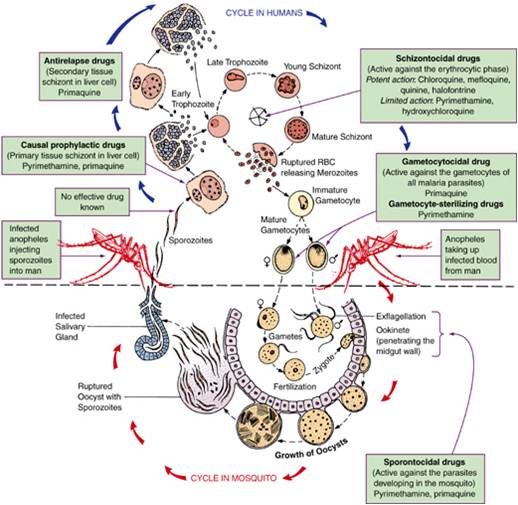7.8.2: Antiprotozoan and Antihelminthic Drugs
- Page ID
- 29042
Antiprotozoan and antihelminthic drugs are characterized based on structure and the mechanism of action by which they target the organism.
- Describe the objective of drugs against helminths anf the disadvantages to developing drugs against protozoa
Key Points
- Antiprotozoan drugs are typically species specific.
- It is essential that antiprotozoan drugs target pathways and mechanisms specific to protozoa as overlap in the basic biology can result in inaccurate targeting of the drug to both the host and protozoa.
- Antihelminthic drugs typically focus on the disruption of structural mechanisms that maintain body structure resulting in paralysis of the helminth which promotes expulsion.
Key Terms
- helminth: A parasitic roundworm or flatworm.
- protozoa: Protozoa are a diverse group of unicellular eukaryotic organisms, many of which are motile. Originally, protozoa had been defined as unicellular protists with animal-like behavior, e.g., movement. Protozoa were regarded as the partner group of protists to protophyta, which have plant-like behavior, e.g., photosynthesis.
- Parasite: Parasitism is a non-mutual relationship between organisms of different species where one organism, the parasite, benefits at the expense of the other, the host.
Parasites are organisms that live on or in a host organism to obtain food. Two major classes of parasitic organisms include protozoa and helminths.
Protozoa are unicellular eukaryotic organisms that are classified as either free-living or parasitic organisms. Protozoa are further classified based on their mode of locomotion and include: Sarcodina (amoeba); Mastigophora (flagellates); Ciliophora (ciliates); and Sporozoa (non motile in adult form). Some examples of diseases caused by protozoa include: Malaria, Giardia, Trichomoniasis, and Leishmaniasis.

Helminths are multicellular eukaryotic organisms that are also classified as either free-living or parasitic chemoheterotrophic organisms. Helminths are parasitic worms and are divided into three major groups including: flatworms (platyhelminths); thorny-headed worms (acanthocephalins); and roundworms (nematodes and hookworms).

The variation that exists between protozoa contributes to complications associated with developing effective drugs. The lack of similarities between protozoans demands the need for highly specific drugs and medications against individual pathogens. In addition, protozoa are eukaryotic and exhibit similar properties and metabolic pathways as human cells. Therefore, the drugs that are developed to target protozoans are classified by either their mechanism of action or the organism for which they target. In terms of mechanism of actions, most antiprotozoan drugs specifically target the organism to prevent its growth and reproduction.
Protozoal diseases can also be prevented by targeting the route of transmission and/or targeting vector organisms. For example, Malaria is caused by the protozoan Plasmodia. This parasite is injected into humans via mosquitoes. The development of antimalarial drugs are based on the life cycle of Plasmodiain both the mosquito and human host.

Other types of antiprotozan drugs specifically target metabolic mechanisms utilized by the parasite. For example, African sleeping sickness is caused by trypanosomes. The drug Eflornithine attacks this parasite by targeting an enzyme responsible for regulating cell division.
Helminths are characterized as various types of parasitic worms, which are effectively targeted by promoting expulsion from the body. Parasitic helminths worms include: tapeworms, flukes, leeches and hookworms. The drugs utilized to target helminths are characterized based on chemical structure and mechanism of action. A few examples of the major drug classes include: piperazine, benzimidazole, levamisole, pyrantel, morantel and emodepside.
LICENSES AND ATTRIBUTIONS
CC LICENSED CONTENT, SHARED PREVIOUSLY
- Curation and Revision. Provided by: Boundless.com. License: CC BY-SA: Attribution-ShareAlike
CC LICENSED CONTENT, SPECIFIC ATTRIBUTION
- Terbinafine. Provided by: Wikipedia. Located at: http://en.Wikipedia.org/wiki/Terbinafine. License: CC BY-SA: Attribution-ShareAlike
- Caspofungin. Provided by: Wikipedia. Located at: http://en.Wikipedia.org/wiki/Caspofungin. License: CC BY-SA: Attribution-ShareAlike
- Squalene epoxidase. Provided by: Wikipedia. Located at: http://en.Wikipedia.org/wiki/Squalene_epoxidase. License: CC BY-SA: Attribution-ShareAlike
- Antifungal medication. Provided by: Wikipedia. Located at: http://en.Wikipedia.org/wiki/Antifun...tion%23Classes. License: CC BY-SA: Attribution-ShareAlike
- Clotrimazole. Provided by: Wikipedia. Located at: http://en.Wikipedia.org/wiki/Clotrimazole. License: CC BY-SA: Attribution-ShareAlike
- Provided by: African Virtual University. Located at: http://oer.avu.org/bitstream/handle/...pdf?sequence=3. License: CC BY-SA: Attribution-ShareAlike
- mycology. Provided by: Wiktionary. Located at: http://en.wiktionary.org/wiki/mycology. License: CC BY-SA: Attribution-ShareAlike
- ergosterol. Provided by: Wiktionary. Located at: http://en.wiktionary.org/wiki/ergosterol. License: CC BY-SA: Attribution-ShareAlike
- Yeartinfection. Provided by: Wikipedia. Located at: http://en.Wikipedia.org/wiki/File:Yeartinfection.JPG. License: CC BY-SA: Attribution-ShareAlike
- Anthelmintic drugs . Provided by: WormBook. Located at: http://www.wormbook.org/chapters/www...gs.html%23sec4. License: CC BY: Attribution
- Anthelmintic drugs . Provided by: WormBook. Located at: http://www.wormbook.org/chapters/www...gs.html%23sec4. License: CC BY: Attribution
- Metronidazole. Provided by: Wikipedia. Located at: http://en.Wikipedia.org/wiki/Metroni...nism_of_action. License: CC BY-SA: Attribution-ShareAlike
- Parasites: About Parasites. Provided by: Centers for Disease Control and Prevention. Located at: http://www.cdc.gov/parasites/about.html. License: Public Domain: No Known Copyright
- Metronidazole. Provided by: Wikipedia. Located at: http://en.Wikipedia.org/wiki/Metroni...nism_of_action. License: CC BY-SA: Attribution-ShareAlike
- Eflornithine. Provided by: Wikipedia. Located at: http://en.Wikipedia.org/wiki/Eflornithine. License: CC BY-SA: Attribution-ShareAlike
- Melarsoprol. Provided by: Wikipedia. Located at: http://en.Wikipedia.org/wiki/Melarsoprol. License: CC BY-SA: Attribution-ShareAlike
- Anthelmintic. Provided by: Wikipedia. Located at: http://en.Wikipedia.org/wiki/Anthelmintic. License: CC BY-SA: Attribution-ShareAlike
- Antiprotozoal agent. Provided by: Wikipedia. Located at: http://en.Wikipedia.org/wiki/Antiprotozoal_agent. License: CC BY-SA: Attribution-ShareAlike
- Anthelmintic drugs . Provided by: WormBook. Located at: http://www.wormbook.org/chapters/www_anthelminticdrugs/anthelminticdrugs.html. License: CC BY: Attribution
- Boundless. Provided by: Boundless Learning. Located at: http://www.boundless.com//microbiolo...ition/parasite. License: CC BY-SA: Attribution-ShareAlike
- helminth. Provided by: Wiktionary. Located at: http://en.wiktionary.org/wiki/helminth. License: CC BY-SA: Attribution-ShareAlike
- protozoa. Provided by: Wikipedia. Located at: http://en.Wikipedia.org/wiki/protozoa. License: CC BY-SA: Attribution-ShareAlike
- Yeartinfection. Provided by: Wikipedia. Located at: http://en.Wikipedia.org/wiki/File:Yeartinfection.JPG. License: CC BY-SA: Attribution-ShareAlike
- Hookworms. Provided by: Wikimedia commons. Located at: http://en.Wikipedia.org/wiki/File:Hookworms.JPG. License: Public Domain: No Known Copyright
- antiprotozoal%20-%20Define%20Antiprotozoal%20Drugs. Provided by: Wikispaces. Located at: http://antiprotozoal.wikispaces.com/...rotozoal+Drugs. License: CC BY-SA: Attribution-ShareAlike
- CDC%20-%20Parasites%20-%20About%20Parasites. Provided by: Centers%20for%20Disease%20Control%20and%20Prevention. Located at: http://www.cdc.gov/parasites/about.html. License: Public Domain: No Known Copyright


